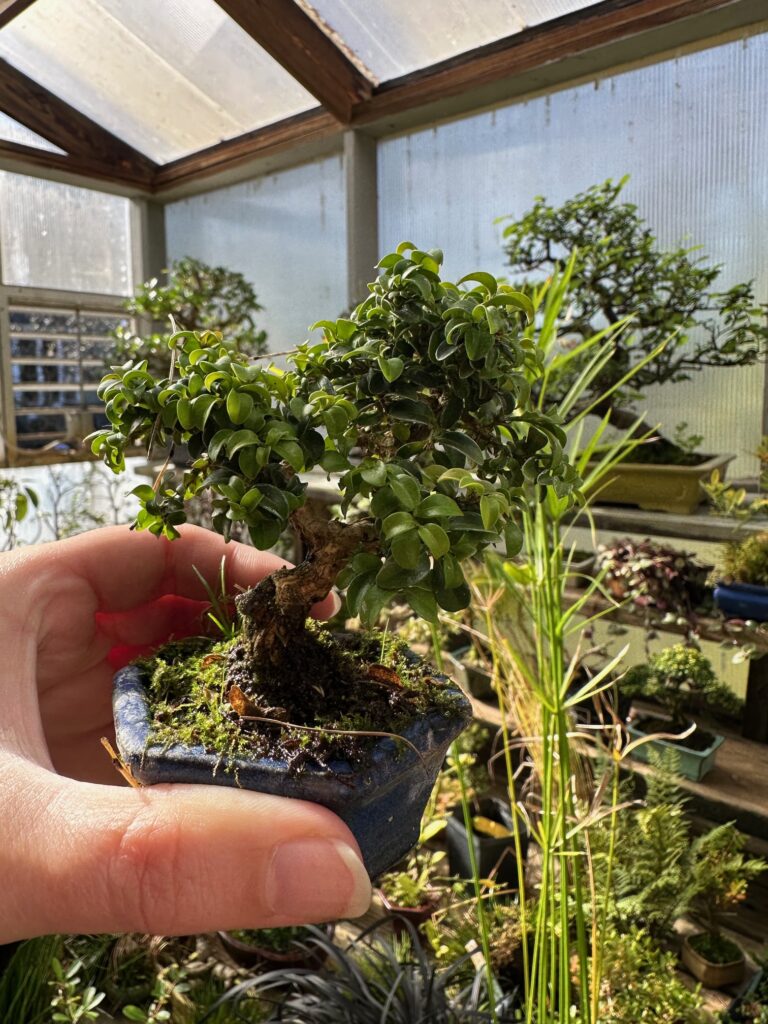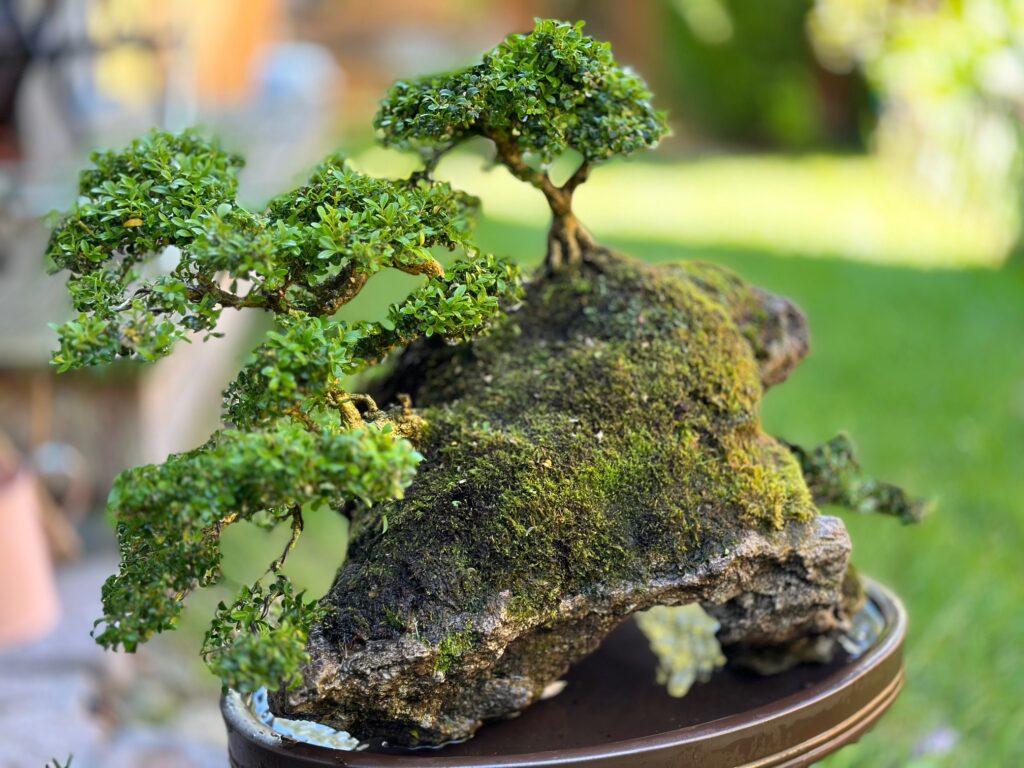
KINGSVILLE BOXWOOD
There are several varieties of Kingsville Boxwood Bonsai, each with unique characteristics. Some of the most popular varieties include the “Compacta,” known for its compact growth habit and small leaves, and the “Morris Midget,” which has a more upright growth habit and smaller leaves than other varieties.
Several styles can create a stunning and unique tree when styling Kingsville Boxwood Bonsai. One popular style is the formal upright style, which involves creating a straight and upright trunk with evenly spaced branches. Another popular style is the informal upright style, which creates a more natural-looking tree with a curved trunk and irregularly spaced branches.
In addition to these styles, Kingsville Boxwood Bonsai can also be styled into various other shapes, such as cascading or semi-cascade styles, which involve creating a tree that looks like it is cascading down a cliff or rock face. Other styles include the broom style, which consists of creating a tree with a straight trunk and evenly spaced branches that resemble a broom, and the windswept style, which involves creating a tree that looks like solid winds have shaped it.
Overall, the Kingsville Boxwood Bonsai is a beautiful and versatile tree that can create various styles and shapes. Whether you are a beginner or an experienced bonsai enthusiast, this tree will provide you with many hours of enjoyment and satisfaction as you create your own unique masterpiece.
If you want to add a touch of elegance and serenity to your home or garden, look no further than a Kingsville boxwood bonsai. This small yet stunning plant is the perfect addition to any space, adding a sense of calm and tranquility with its unique and beautiful appearance.
The Kingsville boxwood bonsai is a type of Japanese boxwood that is native to Asia. It is a slow-growing plant that can take years to reach its full potential, making it a treasured addition to any collection. The plant’s small leaves and intricate branches create a delicate, elegant, refined appearance.
One of the most appealing aspects of the Kingsville boxwood bonsai is its versatility. It can be grown indoors and outdoors, making it the perfect plant for those with limited space. This bonsai thrives in bright, indirect sunlight and requires regular watering to keep it healthy and vibrant.
In addition to its stunning appearance, the Kingsville boxwood bonsai has significant cultural and spiritual significance. In Japan, bonsai trees are seen as symbols of balance, harmony, and peace. They are often used in meditation and are believed to promote a sense of calm and serenity.
Caring for a Kingsville boxwood bonsai requires patience, dedication, and attention to detail. However, the rewards are well worth the effort. This plant can live for decades with proper care, providing a constant source of beauty and tranquility in your home or garden.
Overall, the Kingsville boxwood bonsai is a timeless symbol of elegance and serenity. Whether you are an experienced bonsai enthusiast or simply looking to add a touch of beauty to your space, this plant is a perfect choice. So why not bring a bit of Japanese culture and beauty into your life with a Kingsville boxwood bonsai today?
The Kingsville Boxwood Bonsai is highly prized for its delicate foliage and intricate branching pattern, which can be manipulated and shaped to create various stunning bonsai styles. Its small leaves and dense growth pattern make it ideal for creating a natural-looking miniature tree that resembles a full-sized tree in nature.
In Japanese culture, bonsai trees are considered to symbolize harmony, balance, and peace. They are also believed to represent the beauty and transience of life, as they require careful cultivation and attention to thrive. The Kingsville Boxwood Bonsai is popular among bonsai enthusiasts because of its unique beauty and symbolism.
The Kingsville Boxwood Bonsai requires careful attention and maintenance to thrive, including regular pruning, watering, and fertilization. It is essential to carefully select the suitable soil, pot, and location for the bonsai to ensure its health and longevity.
In conclusion, the Kingsville Boxwood Bonsai is a highly respected and treasured bonsai tree in Japanese culture. Its unique beauty, symbolism, and delicate nature make it popular among bonsai enthusiasts and collectors worldwide. This miniature tree can bring peace, harmony, and beauty to any space with proper care and attention.
Kingsville Boxwood Bonsai is popular among bonsai enthusiasts due to its beautiful foliage and compact size. However, maintaining its shape and size requires proper pruning techniques. This blog post will discuss the dos and don’ts of pruning Kingsville Boxwood Bonsai to help you maintain its health and beauty.
Dos:
1. Use proper tools: Use sharp and clean pruning shears to make clean cuts. Dull or dirty shears can damage the plant and introduce diseases.
2. Prune during the growing season: Prune the Kingsville Boxwood Bonsai during the growing season, usually from spring to fall. This will help the plant to heal faster and recover quickly.
3. Prune selectively: Only remove the necessary branches to maintain the desired shape and size. Never prune more than one-third of the tree at a time.
4. Prune to encourage growth: Prune promotes new growth and maintains a balanced shape. Cut back to a bud facing outward to promote new development in that direction.
Don’ts:
1. Don’t prune during dormancy: Pruning can cause the plant to go into shock and may damage the roots. Wait until the growing season to prune.
2. Don’t remove too much foliage: It can weaken the plant and make it vulnerable to diseases and pests.
3. Don’t use wire to shape the tree: Kingsville Boxwood Bonsai is delicate, and wiring can damage the branches and leaves. Instead, prune to shape the tree.
4. Don’t prune too often: Pruning too frequently can stress the plant and slow down its growth. Only prune when necessary to maintain the shape and size.
In conclusion, pruning Kingsville Boxwood Bonsai requires careful attention and proper techniques. By following the dos and don’ts of pruning, you can maintain the health and beauty of your bonsai tree for years to come.
During the spring and summer, you can keep your Kingsville boxwood bonsai outdoors in a semi-shaded area. In nature, the tree would grow under the tree canopy and not receive direct light, so this arrangement keeps the Kingsville boxwood bonsai happy.
Boxwood can handle some morning sun but needs shade in the afternoon. Be especially careful about exposing Kingsville boxwoods to afternoon sun in hot climates. They won’t appreciate baking in the sun any more than you do.
During the winter, Kingsville boxwoods go semi-dormant. When temperatures begin dropping below freezing regularly, move your tree to a window with indirect sunlight in a cool area (around 50 degrees Fahrenheit, if possible) of your home.
You can also place them in an unheated garage or a cold frame if this will keep the temperature somewhat above freezing. Some people have better luck maintaining boxwood bonsai outside, even in frigid temperatures, because the trees do not enjoy the lack of humidity or the warm inside temperatures during a long winter in the house.
Boxwood bonsai can handle a wide range of temperatures, including relatively cold temperatures. When possible, keep them above freezing during the winter, but don’t allow them to get too warm, as this will prevent the trees from going dormant.
If you bring your Kingsville boxwood bonsai inside during the winter, you must take steps to correct the humidity. Thanks to heating and cooling systems, indoor environments are much less humid.
Mist your boxwood bonsai once a week, and if you bring it inside during the winter, consider placing a humidity tray underneath it for extra humidity.
Bonsai boxwood trees must only be repotted when the roots begin outgrowing the pot. You’ll know when this happens because you’ll start seeing roots coming from the bottom.
To catch the problem earlier, check your bonsai’s roots every spring. Gently lift the tree and its root mass from the pot. If the roots have begun circling the edge of the pot, then it’s time to repot. If there’s still soil outside the root ball, then your tree is probably okay to stay as is for a while.
Bonsai boxwood trees don’t have to be repotted often, though. Generally, evergreens like bonsai boxwoods must only be repotted every 4-5 years.
It’s best to repot bonsai boxwood trees at the beginning of summer when they are at their healthiest. However, if necessary, you can also report them during the fall, but there is a greater chance that the recovery will not go as well.
When repotting, you should trim up to ¼ of the root system and either place the tree back in the original container with new soil or into a new container. Trimming and repotting stress out plants, so keep them shaded and well-watered after the repotting process. Don’t use any fertilizer for a month after repotting because the roots are very vulnerable to burns and damage during this time.





